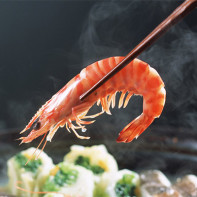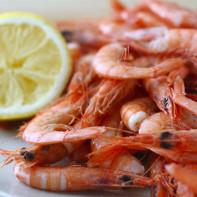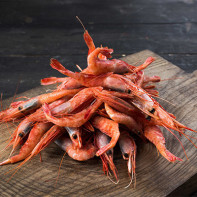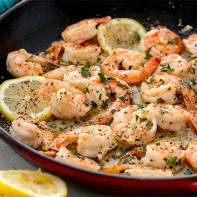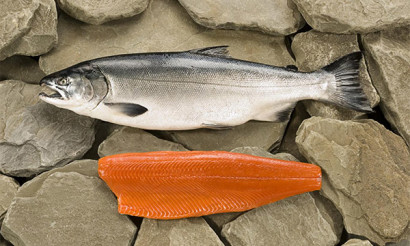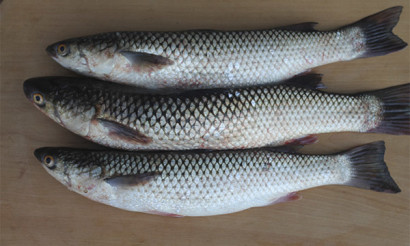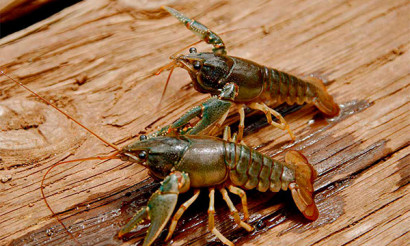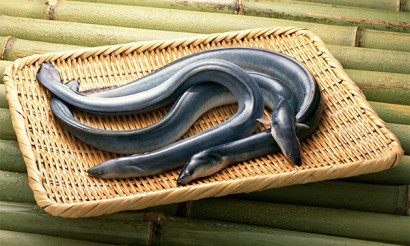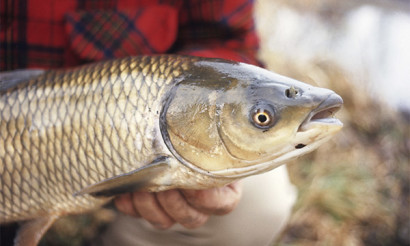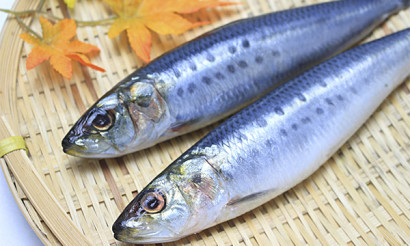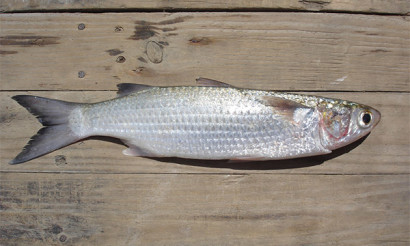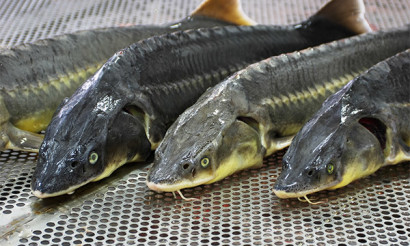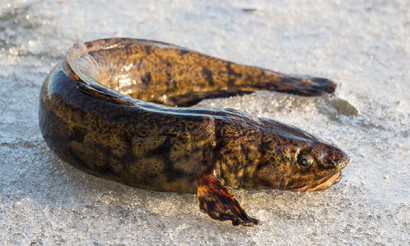Shrimp: benefits and harm to the human body
Shrimps belong to the crustacean family and have many varieties that differ from each other in size, color, habitat and taste characteristics. On the shelves of supermarkets, each buyer can meet a wide variety of raw and prepared shrimp. But how do you choose from a variety of offers those that you can like, and what features does each variety have? Let's figure it out.
- Types of Shrimp for Food
- Tiger
- Royal
- Prawns
- How shrimp differ from langoustines
- Composition and calorie content
- What are the benefits of shrimp?
- For women
- For men
- During pregnancy
- When breastfeeding
- For children
- Can I eat shrimp while losing weight?
- Shrimp in medicine
- With diabetes
- With pancreatitis
- With gastritis
- With gout
- For the liver
- With cholecystitis
- Harm and contraindications
- Shrimp meat allergy symptoms
- Symptoms of Shrimp Poisoning
- How to choose and store shrimp
- How to cook shrimp: recipes
- Boiled
- Fried
- Shrimp sauce
- How to quickly defrost shrimp
- How and what do shrimp eat
- Can I eat shrimp in post
- Is it possible to eat shrimp caviar
- Can Muslims eat shrimp
- Can I eat raw shrimp
- How many shrimp can you eat per day?
- How to clean shrimp
- Can shrimp be given to animals
- Interesting Shrimp Facts
Types of Shrimp for Food
Today, there are more than a hundred varieties of sea shrimp, but the most common are considered:
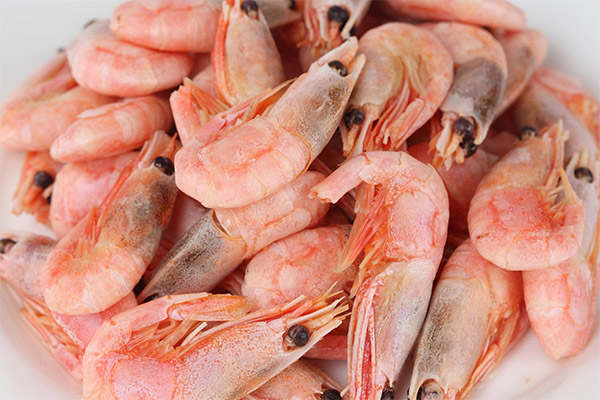
Tiger
Tiger prawns differ from their counterparts in large sizes, unusual color and the presence of a large amount of meat. Each individual of this species can grow up to 40 cm and is painted in a green shade with clearly visible dark stripes. Tiger prawns grow well in special farms. This feature allows you to deliver them to all stores in large quantities. On the shelves you can find not only freshly frozen tiger prawns, shops are also ready to offer them to the buyer in chilled, boiled-frozen and canned form.
Royal
King prawns are characterized by a pleasant taste, large size and the usual, unremarkable color. They can reach 25 cm in length, painted in green, and in some cases even in blue. On the shelves you can find freshly frozen or boiled-frozen king prawns.
Prawns
Northern shrimp have another name - chillim - and differ from other varieties in their small size. Their length does not exceed 11 centimeters, and the taste features exceed all expectations. This type of shrimp can be seen on store shelves only in boiled-frozen form.
How shrimp differ from langoustines
Langoustine has several names and is one of the closest relatives of the lobster. Like each shrimp species, it belongs to the crustacean family. It is painted in an attractive pink or orange color, and its meat has excellent taste characteristics. Langoustine cooks very quickly. Most often, these crustaceans are eaten stewed in broth, without any additional additives.
Shrimp belongs to small crustaceans, which is its main difference from langoustines. These crustaceans also have good taste and excellent aroma. They are very popular and, unlike langoustines, can be cooked in different ways, while maintaining their unique taste.
Composition and calorie content
Shrimp meat contains a large amount of protein, iodine, fatty acids and antioxidants, which explains the beneficial effect of this seafood on the human body.In addition, shrimp contains a large amount of B vitamins, vitamin A, selenium, copper, iron, phosphorus, sodium and even zinc, and the amount of fat in this food product is minimized.
100 grams of shrimp meat contains only 99 calories, which indicates the low calorie content of this unique seafood and allows you to use it even for those people who are trying to reduce their weight.
What are the benefits of shrimp?
The rich composition of shrimp is able to beneficially affect the human body as a whole, improving the functioning of internal organs. Regular consumption of this seafood helps prevent the development of diseases of the cardiovascular system, significantly reduces the risk of stroke, heart attack and hypertension. Shrimp meat exhibits its unique properties only with its regular use. It is able to beneficially influence not only adults, but also children, helping them to develop correctly.
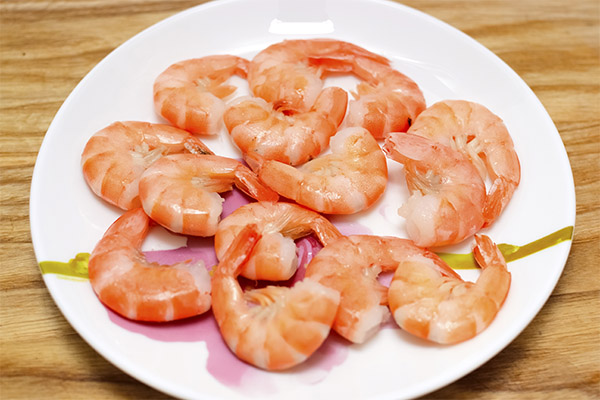
For women
Shrimp meat contains a large number of vitamins and minerals that can improve the condition of the skin, hair and nails. In addition, this seafood helps to smooth the hormonal background and improves the work of female reproductive organs, preventing the development of age-related diseases and pathologies that occur against the background of sudden changes in some hormones.
For men
This product will be indispensable for men. In addition to the vitamin complex, shrimp contains selenium and zinc, which are excellent stimulants for the production of the most important male hormone - testosterone. These trace elements improve potency.
During pregnancy
Many doctors agree that shrimp is an indispensable product for every pregnant woman. The regular use of this seafood will not only saturate the female body, but also guarantee the correct development of the fetus. This product has a positive effect on the baby who is in the womb, and reduces the risk of developing pathologies of the baby’s nervous system.
However, pregnant women should not forget that shrimp meat contains a large amount of cholesterol, the accumulation of which is extremely undesirable. To prevent the accumulation of harmful cholesterol, it is necessary to consult a therapist and establish an acceptable daily intake of this product.
When breastfeeding
Despite all the beneficial properties of shrimp, pediatricians prohibit their introduction into the daily diet of a lactating woman. At least until the child is 3 months old. When the age of the child allows, a young mother is allowed to introduce this seafood into her daily diet. However, this should be done with extreme caution, since any seafood, including shrimp, can cause serious allergic reactions in the infant. If the baby has not identified such unpleasant features, the young mother may well allow herself to enjoy boiled shrimp, which will help her recover from childbirth, replenish vitamins and minerals.
The regular use of shrimp during breastfeeding ensures the availability of all the necessary trace elements and vitamins in the baby's body. In addition, seafood can prevent the development of vitamin deficiency, cancer and other dangerous diseases.
For children
Pediatricians are advised to start introducing shrimp into the diet of a child who has reached the age of three. At the same time, this should be done very carefully, observing the reaction of the child's body. In the event that any negative reactions to the introduction of this seafood are not observed, its amount can be increased to 60 grams per day.
Regular consumption of shrimp will help the child to develop correctly, will have a beneficial effect on his mental and physical development and will saturate the growing body with all the necessary vitamins and minerals.
Can I eat shrimp while losing weight?
Low calorie content, minimal amount of fat and huge benefits of eating allow you to include shrimp in the diet menu. It will help prevent the depletion of the body during the diet and will contribute to weight loss. In addition, seafood is able to speed up the metabolism and contains a minimal amount of fats and carbohydrates, which also helps to reduce body weight.
Of course, like any other food product, shrimp meat can harm the human body. To prevent this seafood from causing any diseases, nutritionists recommend consuming it no more than 2-3 times a week. This will be enough to diversify the diet menu and saturate the body with useful substances.
Shrimp in medicine
Many doctors agree that regular use of shrimp has a beneficial effect on the body and prevents the development of many diseases.

- Hair loss, which can cause zinc deficiency. To fill the deficiency and saturate the human body with this substance will help the regular use of shrimp meat.
- Violations of the thyroid gland. Shrimp contains a large amount of iodine, and the systematic use of this seafood will help improve the functioning of the thyroid gland.
- Stroke and heart attacks. Shrimp contains an enzyme that can prevent blood clots and destroy those that have already appeared, which helps minimize the risk of strokes and heart attacks.
- Crayfish. Selenium and astaxanthin, which are part of shrimp, prevent the development of cancer.
With diabetes
Shrimp is an indispensable food for people who suffer from diabetes. Many minerals and minerals that make up shrimp meat can saturate a weakened body and can help a person cope with concomitant diseases or prevent their development.
Experts advise diabetics to regularly use shrimp, but do not forget about the need to limit their number. In order to support the body, it is enough to eat 100 grams of shrimp meat 1 time per week.
Important: the glycemic index of shrimp is 0 units.
With pancreatitis
In the chronic course of a disease such as pancreatitis, gastroenterologists allow their patients to include shrimp in their daily diet, since the amino acids and taurine contained in their composition contribute to the healing and renewal of tissues. At the same time, experts argue that there is no need to grind shrimp meat, because after cooking it becomes soft and is not able to irritate affected internal organs.
However, gastroenterologists draw the attention of patients to the fact that in acute pancreatitis it is better to abandon shrimp.
With gastritis
For people who suffer from gastritis, gastroenterologists are also not forbidden to eat shrimp. At a time when the disease is not manifested by active symptoms and a pronounced pain syndrome, boiled seafood is allowed. The only thing experts pay attention to: this seafood should be consumed in limited quantities.
With gout
Omega-3, which is part of shrimp, helps relieve pain and alleviate the general condition of a patient who suffers from gout. In addition, the rich composition of this seafood helps to normalize the central nervous, immune, cardiovascular and digestive systems of the patient.
For the liver
Is it worth introducing shrimp into the daily diet of people who suffer from liver diseases? This is a controversial question that only the attending physician can answer based on the characteristics of the body and the specifics of the disease.
With cholecystitis
The diet for cholecystitis does not prohibit the use of shrimp meat.The main thing is to control the amount of seafood eaten and not to eat salt, sauces, spices or alcohol with it.
Experts note that during an exacerbation of the disease, patients will have to completely abandon shrimp and many other products.
Harm and contraindications
Shrimp is one of the most healthy seafood, but over-consumption can lead to allergic reactions. At the same time, an allergy to shrimp meat can appear not only in children, but also in adults, and requires immediate treatment with antihistamines.
In addition, experts note that unlimited consumption of this seafood will lead to an excess of cholesterol, which can negatively affect human health and cause the development of certain diseases.
Doctors note that it is very important to use only high-quality and fresh shrimp. Seafood of poor quality, of doubtful origin or with an expired shelf life can cause serious poisoning.
Shrimp meat allergy symptoms
An allergy to shrimp meat is extremely rare, but has very unpleasant symptoms:
- Very itchy.
- The appearance of a rash or spots on the skin.
- The sharp onset of conjunctivitis.
- Attacks of nausea and vomiting.
- Diarrhea.
- Rapid pulse.
The appearance of one or more symptoms indicates the need to seek medical help. In case of refusal from consultation and treatment, the risk of serious complications increases, which can be dangerous not only for health, but also for human life.
Symptoms of Shrimp Poisoning
Attacks of nausea, vomiting, fever, general weakness, diarrhea and severe pain with localization in the stomach can indicate shrimp poisoning. This condition requires immediate medical attention, otherwise the condition will worsen, and the risk of complications increases.
How to choose and store shrimp
When choosing shrimp, it is important to pay attention to many criteria:
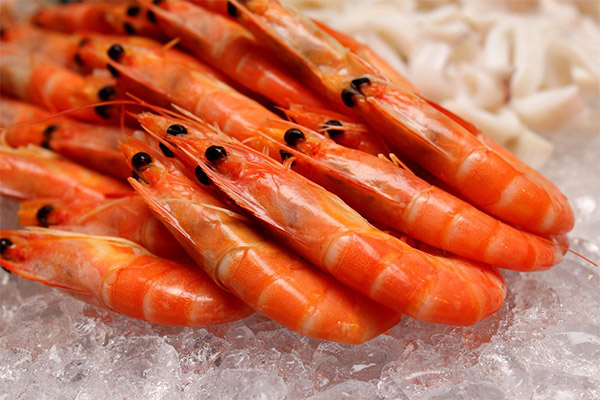
- The quality of freezing. Shrimps that have undergone secondary freezing can be spoiled and hazardous to health. To make sure that the shrimp were not thawed and did not undergo secondary freezing, slightly press on the package. The presence of a crunch when pressed indicates that this seafood is not worth buying.
- Smell. Shrimp should have a pleasant marine aroma. The presence of external odors indicates that the product is spoiled.
- Colour. The pink shade of raw shrimp indicates their dubious quality.
How to store
Shrimp can be stored frozen or chilled. Frozen seafood can be stored for 2 months, and chilled seafood is best consumed as quickly as possible and not keep them for more than 48 hours.
How to cook shrimp: recipes
There are many recipes for making shrimp, each of which has its own taste. The most common cooking methods for these seafood are cooking and frying.
Boiled
The taste and unique aroma of boiled shrimp is familiar to every person, but far from everyone knows how to cook them correctly. To make boiled shrimp tasty and fragrant, you will need:
- Water.
- Salt.
- Sugar.
- Spice.
In 2.5 liters of boiling water, add 3 full tablespoons of salt, 2 tablespoons of granulated sugar and your favorite spices. Thawed shrimp should be placed in water and cooked over medium heat for 3-4 minutes.After that, leave the shrimp in hot water for another 10 minutes.
Shrimps prepared according to this recipe are served in a deep dish with a small amount of broth.
Fried
The most popular fried shrimp recipe is this seafood appetizer with soy sauce and lemon juice.
For cooking you will need:
- 1 kg of shrimp.
- Some olive oil.
- 2-3 small cloves of garlic.
- Soy sauce.
- Lemon juice.
To prepare this snack, you need to heat the olive oil in a deep pan, pour out thawed and peeled shrimps there and fry for 3-4 minutes. After roasting, add garlic, 2 tablespoons of soy sauce and juice of half a lemon. The appetizer should be kept on fire for another 1-2 minutes and served immediately.
Shrimp sauce
Shrimp sauce is able to reveal all the taste features of this seafood and emphasize their uniqueness. The most popular is cream sauce, for the preparation of which you will need:
- Cream.
- Lemon juice.
- Oregano.
- Garlic.
- Spice.
- Butter.
In melted butter, add 1 finely chopped head of garlic and lightly fry it, then pour 200 ml of cream into a pan and set a minimum heat. After 5 minutes, add half a tablespoon of natural lemon juice and spices. This sauce will be a great addition to any shrimp appetizer.
How to quickly defrost shrimp
Shrimp should be thawed at room temperature. However, boiled-frozen shrimp can be placed for several minutes in salted boiling water or in a pan with hot oil.
How and what do shrimp eat
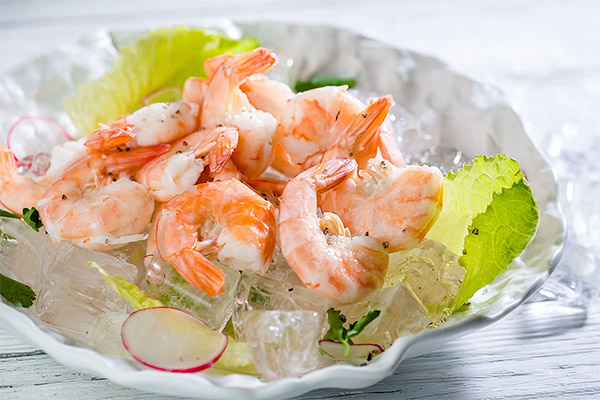
There are many varieties of serving shrimp, but the most common are:
- Grilled shrimp with uncleaned tail.
- Shrimp cocktail.
- Boiled shrimp.
Fried shrimp should be taken by the tail by hand and bite off the part that does not have a shell, a shrimp cocktail is eaten with a special dessert fork, and boiled shrimp is cleaned by hand and eat using a regular fork.
Most often, various sauces are served with this seafood, into which peeled shrimp are dipped, and then eaten.
Can I eat shrimp in post
Shrimp is a product of animal origin. Therefore, they should be excluded from the diet during fasting.
Is it possible to eat shrimp caviar
You can eat shrimp caviar, but not everyone will like its taste. It tastes significantly different from shrimp meat and not many like it. However, there are also shrimp caviar lovers who eat it with great pleasure.
Can Muslims eat shrimp
Muslims eat those animals that are not able to stay on land for a long time. These include shrimp.
Can I eat raw shrimp
Shrimp, which many people consider raw, has already undergone heat treatment and are not. Such a product can be eaten immediately after a complete defrost. The main thing is to pay attention to the expiration date and product quality.
How many shrimp can you eat per day?
Shrimps contain protein, fat and many useful trace elements that can beneficially affect the human body, the work of internal organs and systems. However, this seafood also contains a large amount of cholesterol, the accumulation of which can negatively affect health. That is why experts strongly recommend that you do not abuse this food product and do not exceed the daily norm, which is 100 grams.
How to clean shrimp
Shrimps are usually cleaned by hand, but for those who eat this seafood for the first time, cleaning can cause a lot of questions.
Shrimp should be cleaned in the correct sequence:
- First, remove the head and all the legs of the shrimp. This can be done by holding them with your fingers and pulling.
- Next, clean the shell. Its removal should begin from the head, removing each plate.
- After the shell is removed, you should tear off the tail, holding it with two fingers.
Shrimp is completely peeled and ready to eat!
Can shrimp be given to animals
Veterinarians are allowed to give animals a small amount of shrimp meat, boiled without the addition of salt and spices. This treat is especially good for cats. This is due to the content of a small number of calories and the presence in the composition of a large amount of protein. In addition, the rich composition of shrimp will help maintain the health of the pet and saturate its body with all the necessary substances.
However, it is not recommended to include shrimp in the daily diet of an animal, as this can provoke the development of some diseases and cause overweight.
In order to please a furry pet, experts advise choosing only high-quality, natural, fresh shrimp. Otherwise, this seafood can cause poisoning.
Interesting Shrimp Facts
Shrimp is one of the most popular seafood, which is very popular in many countries. Many people know about the unique taste of this food product, but few people know some interesting facts:
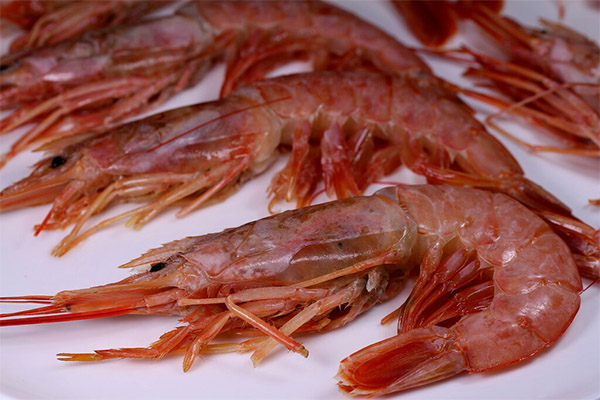
- Some varieties of shrimp can reach 35 centimeters in length.
- Shrimp are hermaphrodites and are able to change their gender.
- This seafood is low-calorie and is included in the menu of many diets, the purpose of which is to reduce weight.
- The famous Chinese artist became famous due to the fact that he depicted a variety of shrimp in his paintings.
- Shrimp are able to live not only in sea, but also in fresh water.
- The largest shrimp reaches a length of 35 cm and weighs 650 grams.
- Shrimps regularly drop their carapace and grow a new one.
- This seafood was consumed by the ancient Greeks and Romans. They fried, baked and boiled it.
- Shrimp cook very quickly. It only takes a few minutes to cook them.
- Shrimp can have a beneficial effect on the cardiovascular system, help cope with the jumps in blood pressure and rejuvenate the body.
- Anomalocaris, which lived on the earth 500 million years ago, is the ancestor of modern shrimp.
- A unique feature of shrimp is that their organs of vision are able to move in opposite directions and are placed on special processes.
- The heart of the shrimp is not located in the body, but in the head.
- In the natural habitat, individuals are found that are able to live for about 20 years.
With moderate use, the benefits of shrimp for the human body are obvious. But it is worth remembering that an important factor when choosing shrimps is their habitat. If they are caught in clean regions or grown on a farm without the use of hormones and other growth stimulants, the benefits of shrimp will be 100%. Therefore, when buying, pay attention to the manufacturer: it is better to give preference to well-known and trusted companies. Shrimp - one of those products on which it is better not to save. If you want to get the maximum benefit from their use, pay attention first of all not to price, but to quality.
«Important: all information on the site is provided exclusively in fact-finding purposes. Before applying any recommendations, consult with a profile specialist. Neither the editors nor the authors are liable for any possible harm caused materials. "

